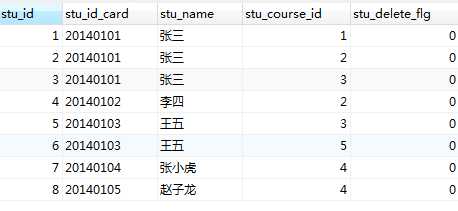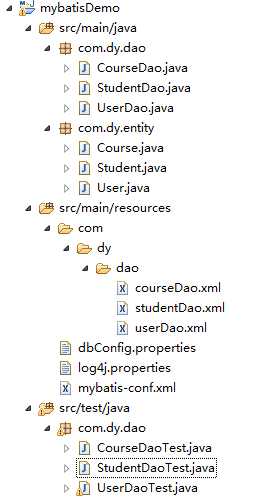标签:idc 标示 res nbsp hsi statement images timeout 高级
原文地址:http://www.cnblogs.com/dongying/p/4073259.html
先看select的配置吧:
<select
<!-- 1. id (必须配置)
id是命名空间中的唯一标识符,可被用来代表这条语句。
一个命名空间(namespace) 对应一个dao接口,
这个id也应该对应dao里面的某个方法(相当于方法的实现),因此id 应该与方法名一致 -->
id="selectPerson"
<!-- 2. parameterType (可选配置, 默认为mybatis自动选择处理)
将要传入语句的参数的完全限定类名或别名, 如果不配置,mybatis会通过ParameterHandler 根据参数类型默认选择合适的typeHandler进行处理
parameterType 主要指定参数类型,可以是int, short, long, string等类型,也可以是复杂类型(如对象) -->
parameterType="int"
<!-- 3. resultType (resultType 与 resultMap 二选一配置)
resultType用以指定返回类型,指定的类型可以是基本类型,可以是java容器,也可以是javabean -->
resultType="hashmap"
<!-- 4. resultMap (resultType 与 resultMap 二选一配置)
resultMap用于引用我们通过 resultMap标签定义的映射类型,这也是mybatis组件高级复杂映射的关键 -->
resultMap="personResultMap"
<!-- 5. flushCache (可选配置)
将其设置为 true,任何时候只要语句被调用,都会导致本地缓存和二级缓存都会被清空,默认值:false -->
flushCache="false"
<!-- 6. useCache (可选配置)
将其设置为 true,将会导致本条语句的结果被二级缓存,默认值:对 select 元素为 true -->
useCache="true"
<!-- 7. timeout (可选配置)
这个设置是在抛出异常之前,驱动程序等待数据库返回请求结果的秒数。默认值为 unset(依赖驱动)-->
timeout="10000"
<!-- 8. fetchSize (可选配置)
这是尝试影响驱动程序每次批量返回的结果行数和这个设置值相等。默认值为 unset(依赖驱动)-->
fetchSize="256"
<!-- 9. statementType (可选配置)
STATEMENT,PREPARED 或 CALLABLE 的一个。这会让 MyBatis 分别使用 Statement,PreparedStatement 或 CallableStatement,默认值:PREPARED-->
statementType="PREPARED"
<!-- 10. resultSetType (可选配置)
FORWARD_ONLY,SCROLL_SENSITIVE 或 SCROLL_INSENSITIVE 中的一个,默认值为 unset (依赖驱动)-->
resultSetType="FORWARD_ONLY">
注:resultType设置的是一个类型,如设置为map,那么sql的结果应该可以是Map(只有一行)
,或者List(Map),(有多行),对于java bean也是一样。其实对应的是Session对象的selectList和selectOne方法。
配置看起来总是这么多,不过实际常用的配置也就那么几个,
根据自己的需要吧,上面都已注明是否必须配置。
下面还是上个demo及时练练手吧:
------------------------------------------------------------------------下面是针对select 的练手demo---------------------------------------------------------------------------------------
数据库:新增两张表(t_course, t_student)
t_course:

t_student:

其中,1个student可选择多个course进行学习。
我们还是拿上篇文章的demo, 继续写:
增加后,项目目录如下所示:

Course.java:
package com.dy.entity;
public class Course {
private int id;
private String name;
private int deleteFlag;
public int getId() {
return id;
}
public void setId(int id) {
this.id = id;
}
public String getName() {
return name;
}
public void setName(String name) {
this.name = name;
}
public int getDeleteFlag() {
return deleteFlag;
}
public void setDeleteFlag(int deleteFlag) {
this.deleteFlag = deleteFlag;
}
}
Student.java:
package com.dy.entity;
import java.util.List;
public class Student {
private int id;
private String idCard;
private String name;
private List<Course> courseList;
private int deleteFlag;
public Student(int id, String idCard, String name, List<Course> courseList, int deleteFlag) {
this.id = id;
this.idCard = idCard;
this.name = name;
this.courseList = courseList;
this.deleteFlag = deleteFlag;
}
public int getId() {
return id;
}
public void setId(int id) {
this.id = id;
}
public String getIdCard() {
return idCard;
}
public void setIdCard(String idCard) {
this.idCard = idCard;
}
public String getName() {
return name;
}
public void setName(String name) {
this.name = name;
}
public List<Course> getCourseList() {
return courseList;
}
public void setCourseList(List<Course> courseList) {
this.courseList = courseList;
}
public int getDeleteFlag() {
return deleteFlag;
}
public void setDeleteFlag(int deleteFlag) {
this.deleteFlag = deleteFlag;
}
}
CourseDao.java:
package com.dy.dao;
import com.dy.entity.Course;
public interface CourseDao {
public Course findCourseById(int courseId);
}
StudentDao.java:
package com.dy.dao;
import com.dy.entity.Student;
public interface StudentDao {
public Student findStudentById(String idCard);
}
courseDao.xml:
<mapper namespace="com.dy.dao.CourseDao">
<!--
1.此处直接将resultType 设置为course, 一看就知道我设置了别名吧,如果没有设置别名,那么resultType = com.dy.entity.Course。
2.可能细心的你会发现:Course.java中的属性名与数据库字段名不一致,下面,我就在sql语句中用了as, 使之匹配,当然方法不止一种,
在学习了resultMap之后,你能看到一种更直观优雅的方式去将javabean中的属性与数据库字段名保持一致
3.findCourseById 与CourseDao中findCourseById方法对应, 那么传入的参数名称以及类型也应该保持对应关系。
4.可以看到,在sql语句中,通过#{}表达式可以获取参数。
5.下面这条sql语句,实际上的形式是怎么样的?还记得之前说过,mybatis默认为preparedStatement吧,那么,用我们jdbc代码来看,它其实就是:
select course_id as id, course_name as name, course_delete_flg as deleteFlag from t_course where course_id=?
-->
<select id="findCourseById" resultType="course" >
select course_id as id, course_name as name, course_delete_flg as deleteFlag from t_course where course_id=#{courseId}
</select>
</mapper>
CourseDaoTest.java:
package com.dy.dao;
import java.io.IOException;
import org.apache.ibatis.io.Resources;
import org.apache.ibatis.session.SqlSession;
import org.apache.ibatis.session.SqlSessionFactory;
import org.apache.ibatis.session.SqlSessionFactoryBuilder;
import org.junit.Test;
import com.dy.entity.Course;
public class CourseDaoTest {
@Test
public void findCourseById() {
SqlSessionFactory sqlSessionFactory = getSessionFactory();
SqlSession sqlSession = sqlSessionFactory.openSession();
CourseDao courseDao = sqlSession.getMapper(CourseDao.class);
Course course = courseDao.findCourseById(1);
}
//Mybatis 通过SqlSessionFactory获取SqlSession, 然后才能通过SqlSession与数据库进行交互
private static SqlSessionFactory getSessionFactory() {
SqlSessionFactory sessionFactory = null;
String resource = "mybatis-conf.xml";
try {
sessionFactory = new SqlSessionFactoryBuilder().build(Resources
.getResourceAsReader(resource));
} catch (IOException e) {
e.printStackTrace();
}
return sessionFactory;
}
}
上面的示例,我们针对course, 简单演示了 select的用法,
不过有个问题值得思考: 一个student可以对应多个course, 那么,在mybatis中如何处理这种一对多,
甚至于多对多,一对一的关系呢?
这儿,就不得不提到 resultMap 这个东西, mybatis的resultMap功能可谓十分强大,能够处理复杂的关系映射,
那么resultMap 该怎么配置呢?
别急,这就来了:
resultMap的配置:
<!--
1.type 对应类型,可以是javabean, 也可以是其它
2.id 必须唯一, 用于标示这个resultMap的唯一性,在使用resultMap的时候,就是通过id指定
-->
<resultMap type="" id="">
<!-- id, 唯一性,注意啦,这个id用于标示这个javabean对象的唯一性, 不一定会是数据库的主键(不要把它理解为数据库对应表的主键)
property属性对应javabean的属性名,column对应数据库表的列名
(这样,当javabean的属性与数据库对应表的列名不一致的时候,就能通过指定这个保持正常映射了)
-->
<id property="" column=""/>
<!-- result与id相比, 对应普通属性 -->
<result property="" column=""/>
<!--
constructor对应javabean中的构造方法
-->
<constructor>
<!-- idArg 对应构造方法中的id参数 -->
<idArg column=""/>
<!-- arg 对应构造方法中的普通参数 -->
<arg column=""/>
</constructor>
<!--
collection,对应javabean中容器类型, 是实现一对多的关键
property 为javabean中容器对应字段名
column 为体现在数据库中列名
ofType 就是指定javabean中容器指定的类型
-->
<collection property="" column="" ofType=""></collection>
<!--
association 为关联关系,是实现N对一的关键。
property 为javabean中容器对应字段名
column 为体现在数据库中列名
javaType 指定关联的类型
-->
<association property="" column="" javaType=""></association>
</resultMap>
好啦,知道resutMap怎么配置后,咱们立即接着上面的demo来练习一下吧:
------------------------------------------------------------------下面是用resultMap处理一对多关系的映射的示例-------------------------------------------------------------
一个student对应多个course,
典型的一对多,咱们就来看看mybatis怎么配置这种映射吧:
studentDao.xml:
<mapper namespace="com.dy.dao.StudentDao">
<!-- 这儿定义一个resultMap -->
<resultMap type="student" id="studentMap">
<!--
数据库中主键是id, 但是我这儿却是指定idCard为主键,为什么?
刚刚讲了,id用来表示唯一性, 我们可以认为只要idCard一样,那么他就是同一个学生。
如果此处用数据库中id, 那么mybatis将会认为数据库中每条记录都是一个student, 这显然不符合逻辑
-->
<id property="idCard" column="stu_id_card"/>
<result property="id" column="stu_id"/>
<result property="name" column="stu_name"/>
<result property="deleteFlag" column="stu_delete_flg"/>
<!--
这儿就是实现一对多的关键。
在Student中,courseList为List<Course>, 因此,ofType也应该与之对应(当然,我用了别名,不然要蛋疼的写全名了)。
collection的子标签是在指定Course的映射关系(由于Course的javabean的属性名与数据库的列名不一致)
-->
<collection property="courseList" column="stu_course_id" ofType="Course">
<id property="id" column="course_id"/>
<result property="name" column="course_name"/>
<result property="deleteFlag" column="course_delete_flg"/>
</collection>
</resultMap>
<!-- 这儿将返回类型设置成了上面指定的studentMap -->
<select id="findStudentById" resultMap="studentMap">
SELECT s.*, c.* FROM t_student s LEFT JOIN t_course c ON s.stu_course_id=c.course_id WHERE s.stu_id_card=#{idCard}
</select>
</mapper>
StudentDaoTest.java:
package com.dy.dao;
import java.io.IOException;
import java.util.List;
import org.apache.ibatis.io.Resources;
import org.apache.ibatis.session.SqlSession;
import org.apache.ibatis.session.SqlSessionFactory;
import org.apache.ibatis.session.SqlSessionFactoryBuilder;
import org.junit.Test;
import com.dy.entity.Course;
import com.dy.entity.Student;
public class StudentDaoTest {
@Test
public void findCourseById() {
SqlSessionFactory sqlSessionFactory = getSessionFactory();
SqlSession sqlSession = sqlSessionFactory.openSession();
StudentDao studentDao = sqlSession.getMapper(StudentDao.class);
Student student = studentDao.findStudentById("20140101");
List<Course> courseList = student.getCourseList();
for (Course course: courseList) {
System.out.println(course.getId() + " " + course.getName());
}
}
//Mybatis 通过SqlSessionFactory获取SqlSession, 然后才能通过SqlSession与数据库进行交互
private static SqlSessionFactory getSessionFactory() {
SqlSessionFactory sessionFactory = null;
String resource = "mybatis-conf.xml";
try {
sessionFactory = new SqlSessionFactoryBuilder().build(Resources
.getResourceAsReader(resource));
} catch (IOException e) {
e.printStackTrace();
}
return sessionFactory;
}
}
关联映射在我的项目里很少用到,一般的查询不是两张表能够解决的。对于报表统计的复杂查询,可以直接写sql语句,然后把returntype设置为map,就可以得到一个list<map>。传入的参数,可以设置为map。参考文章http://lafecat.iteye.com/blog/2218977
相信通过以上demo,
大家也能够使用mybatis的select 和 resultMap的用法了。上面demo只演示了一对多的映射,其实多对一、多对多也与它类似,所以我就没演示了,有兴趣的可以自己动手再做做。
mapper映射文件配置之select、resultMap(转载)
标签:idc 标示 res nbsp hsi statement images timeout 高级
原文地址:http://www.cnblogs.com/xiaolang8762400/p/7011663.html


